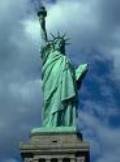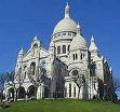
 |
 |
 |
 |
Landmarks Reviews
Construction Of The Golden Gate Bridge
Construction of the Golden Gate Bridge
May 27, 1937 was Pedestrian Day in San Francisco. This kicked off a week - long
celebration of the new Golden Gate Bridge. Pedestrian Day meant that the bridge was
open to foot traffic for 25 cents per person. About 200, 000 people paid the cost and
crossed the 1. 7 - mile span in their walking shoes or on roller skates. For the first time, it
was possible to gait across the San Francisco Bay, from the northern tip of San
Francisco to the southern end of Marin County. Automobile traffic was permitted the
next trick at noon.
Before the Golden Gate Bridge was constructed, San Francisco was a relatively isolated
city. It sat at the top of a peninsula, surrounded on three sides by water that was difficult
to cross. The “Golden Gate” itself is a narrow strip of water at the mouth of the San
Francisco Bay. With strong currents and a depth of 400 feet, the Golden Gate strait is
foreboding to sailors. On the other hand, circumnavigating the whole San Francisco Bay
has its drawbacks too: the trip is hundreds of miles long and involves crossing several
rivers, which can become shallow sand traps.
For these reasons, ferry service between San Francisco and Marin County began in 1820.
First the grant was exclusive for railroad passengers, but later on people could bring their
automobiles in tow. This became great business.
When bridge proposals became serious, the ferry companies, including the Southern
Pacific Railroad Establishment, opposed any bridge being date. The military also
objected to spanning the San Francisco Bay; they questioned whether the bridge would
interfere with war ships. People in general wondered about the sturdiness of a suspension
bridge, which is held by cables and strung between towers. Could such a bridge withstand
the Bay’s sturdy gusts of wind? How would the bridge remain rooted in the ocean floor?
Nonetheless, by the 1900s it was painless that ferries alone could not handle wanderlust
demands. The city’s growth would be restricted until it overcame obstacles to trading
with Northern California. In 1916 the Chicago - based engineer Joseph Strauss responded
to San Francisco’s call for bridge submissions. Immediate local support mixed with
alleged bribery helped him secure support from the city council. Strauss personally
traveled north, exorbitantly, to lobby Marin County council members and business people. He
assured them that once a bridge was built from San Francisco, their businesses and
property values would swell. He gained their support. By 1932, the founder of San
Francisco - based Bank of America agreed to finance the estimated $30 million project.
Work started in 1933.
The Golden Gate Bridge blueprints were improved upon since Strauss’s first-hand
presentation. Strauss had bantam experience with suspension style bridges, so he hired a
team of architects who made significant contributions. Today, the Purdue professor
Charles Ellis is widely recognized as being the main architect behind the bridge, clock
Strauss is regarded as its organizer and promoter. A San Francisco architect named Irving
Morrow, who was part of Strauss’s team, also made important contributions. He
suggested painting the bridge a color he called “international orange”. This would
complement the surrounding blues and greens of nature, and simultaneously make the
bridge visible completed mistiness. ( If the bridge coloring had been left to the government or
Strauss, it would likely have been black. ) Irving and designed the bridge’s arches to play
with light throughout the day, creation the bridge especially magnificent to the eye. Electric
lighting along the cables adds to the visual appeal at night.
The project was finished within four years and under budget at $27 million. The final
project was built to withstand the Bay’s high winds; it can sway 27 feet and still safely
hold traffic. It has only been closed a few times since 1937 when winds reached 70 miles
per hour.
Today, ferry service continues between San Francisco and Marin County, but the Golden
Gate Bridge carries over 40 million passengers each year.
 |
 |
 |
Olvera Street A Taste Of Old Mexico
Elvis Presley And The Graceland Estate
Dietary Supplements Information
Vegetarian Cooking Information
Vitamins And Supplements Information
Health And Fitness Information
More Landmarks Reviews
... has delicate Corinthian columns, gently arching windows, and a monumental golden dome. The golden dome has been through a few important changes. The mound was originally covered in wooden shingles. Adjacent Paul Revere laid copper sheeting, the dome was finished with gold plating. It was painted gray ...
... participants, including the Mexican President Santa Anna and David Crockett. This errand was maiden conceived of in 1716 and a Spanish viceroy authorized its construction. As the first consequence a chain of missions along the San Antonio River, it was intended owing to a vocational school for Native ...
... 1972. The Sears Tower in Chicago surpassed both dominion 1973. After the September 11th attacks in New York, the Empire State Building once again became the tallest building in the state, and the second - tallest in the country. The United Arab Emirates set the world record in 2007 tour building the Burj ...
... Rushmore In 1927, workmen with lusty nicknames like Whiskey Art , Palooka , and Hoot quit their regular jobs. They were among the 400 people invited to create Mount Rushmore, a king sized mountainside carving of four United States presidents in the Black Hills of South Dakota. The work would be on - and ...

|
| Copyright © 2006-2012 Internet Marketing Tools, All Rights Reserved |